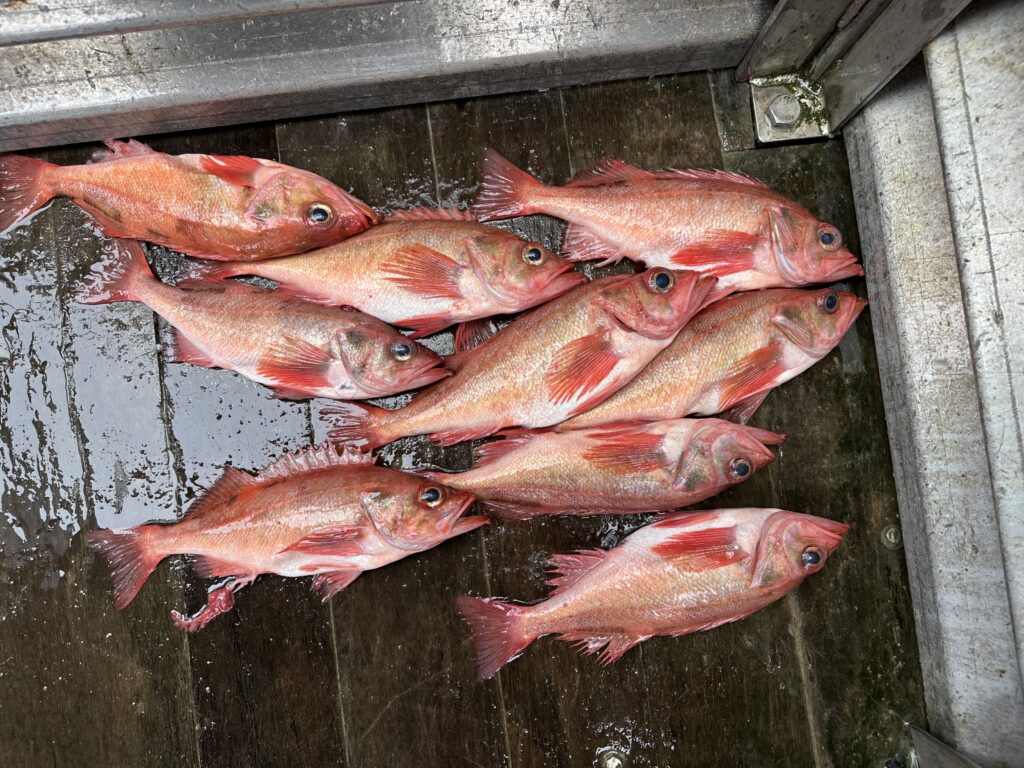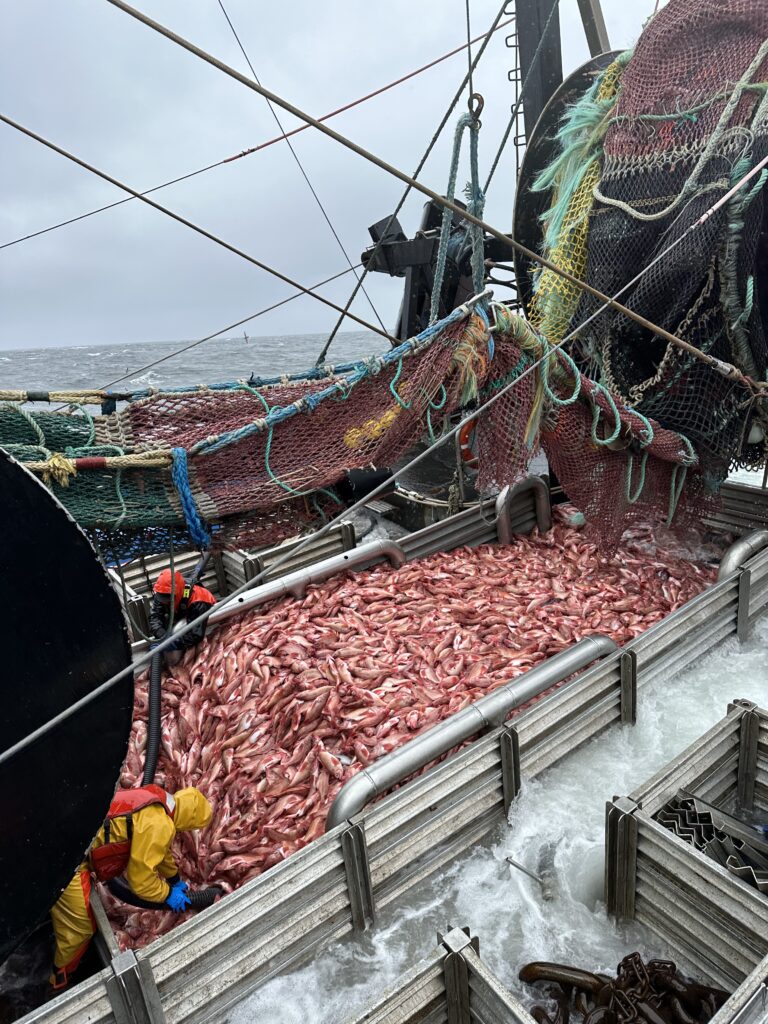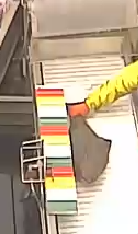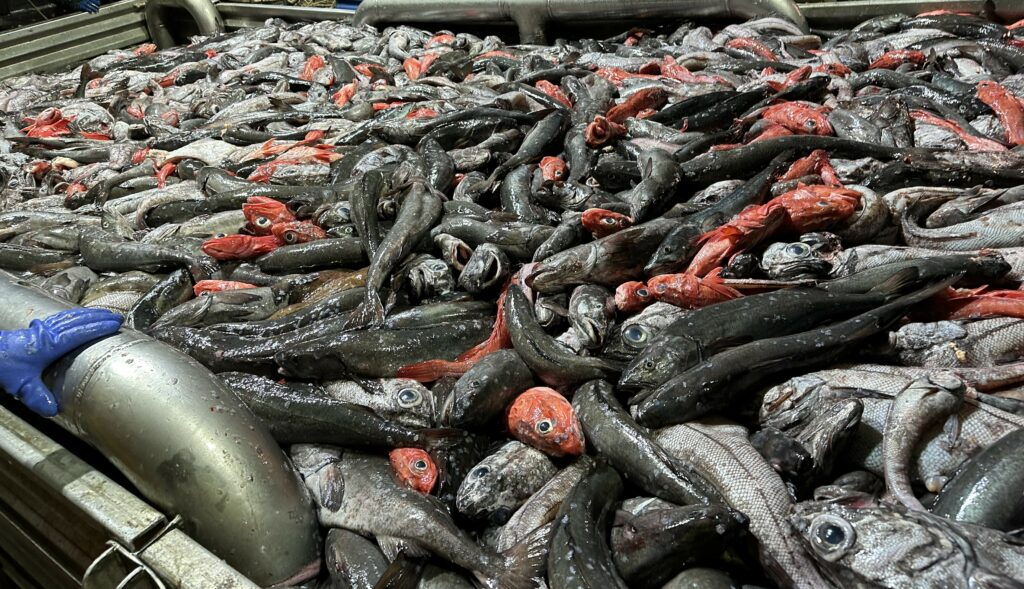Introduction
Gulf of Alaska (GOA) trawl fishermen have been strong proponents of using Electronic Monitoring (EM) to improve monitoring and data accountability in their fisheries and are now working to expand EM from the pelagic pollock fishery to the CGOA Rockfish Program (RP), where they use both pelagic and non-pelagic gear. As a short-duration, high-cost fishery with a 100% monitoring requirement, using EM and other technology to provide cost-effective monitoring and better PSC accounting has always been a goal for the trawl catcher vessels (CVs). In 2007 and 2008, Alaska Groundfish Data Bank (AGDB) received Exempted Fishing Permits (EFPs) to test the use of EM to quantify at-sea halibut discards in the RP. While the EFPs showed that EM was possible, limitations in the use of EM at the time meant it was not a cost-effective or feasible option to implement at scale.
Fast forward more than fifteen years later, and the EM capacity of the GOA trawl fleet has grown substantially with the pelagic pollock trawl EM program, which has operated as an EFP since 2020 and will be a fully regulated program beginning in 2025. There is significant overlap between the CGOA pollock and rockfish fisheries; of the 26 vessels that regularly participate in the CGOA RP, all are also pollock fishermen, and 23 of these vessels already have EM systems that they use in the pelagic pollock trawl EM program. Significant issues with observer availability, the number of down days between trips, and increasingly expensive observer costs for the CGOA RP led us to take another look at EM for the fishery in 2022. Having EM systems already on the vessels and all the protocols in place for the pollock fishery is a large cost savings if they could also be applied in the RP fishery.

Fishery Background
The CGOA RP is a catch share program with a cooperative structure that allocates Pacific ocean perch (POP), dusky rockfish, northern rockfish, Pacific cod, sablefish, and thornyhead rockfish. Halibut Prohibited Species Catch (PSC) is allocated to the individual vessel level, but a 1,200 cap on Chinook is a sector wide cap that is shared amongst the fleet. The program’s landing requirement means that the fishery operates exclusively out of Kodiak. Alaska Groundfish Data Bank (AGDB) acts as the cooperative manager for all five shoreside cooperatives and the Intercooperative manager.
The GOA CV fleet is largely independently owned, and the nature of their fisheries requires vessel operators to be dynamic with their fishing plans. This includes switching between pelagic and non-pelagic gear throughout the year and within the rockfish season; most vessels have two net reels to allow for this flexibility. Rockfish trips often consist of multiple targets and both pelagic and non-pelagic hauls on a single trip. A constraining factor preventing further EM adoption across the GOA into all trawl fisheries is the need to develop EM protocols for non-pelagic trawl gear since vessels are only allowed to only deploy pelagic gear when operating under the pollock EM program.

The Rockfish fishery has seen several changes since the original EM testing occurred in 2007 and 2008. Rockfish harvests are now dominated by POP, which are primarily harvested with pelagic gear. The quota for this species is five times higher than in 2007; POP continues to be a “winner” in warming ocean temperatures due to climate change. Observer availability has also become a significant issue in recent years, with some vessels having to wait days or even more than a week to get an observer before leaving. Currently, both halibut PSC and Chinook PSC are accounted for based on extrapolated at-sea basket samples which is less precise than census counts and all monitoring takes place at sea;there is no shoreside monitoring component. While halibut PSC has decreased over the history of the RP, which is one of the successes of cooperative programs like the RP, the focus has shifted to the more constraining chinook PSC management.
Hauls targeting POP, northern, and dusky rockfish (regardless of whether pelagic or non-pelagic gear is used) have minimal incidental catch, and maximized retention is possible. However, non-pelagic hauls targeting sablefish and cod typically include halibut PSC and incidental catch of other groundfish species, which are subject to Maximum Retainable Amount (MRA) limits. Halibut PSC and groundfish catch above the MRA limit must be discarded at sea.
2022-2023: Collection of Test Data and Pilot Phase I
In spring 2022, faced with a shortage of observers for the upcoming season, the CV’s Intercooperative Board voted to request AGDB submit a proposal to begin work on Rockfish EM again. At the time, pollock EM for the GOA and BSAI was headed for Final Action at the North Pacific Fisheries Management Council (NPFMC) later in the year, but a fully-operational regulated program was all but inevitable given the intensely collaborative EFP process that brought the industry, Observer Program, Alaska Region, EM Service, Data Review, and Observer providers together. The development of EM in Alaska’s trawl fleet is voluntary, but has always been industry and vessel driven. It was the natural next step for captains to see the opportunity to expand EM into the RP.
During the 2022 rockfish season, vessels elected to turn their existing EM systems on and collect video data while operating under status quo, including carrying human observers. This allowed the unique opportunity to see typical operations and catch handling across five different vessels, twenty-five unique fishing trips, and over ninety hauls. One of our project partners, Archipelago, reviewed the 2022 fishery test data to inform the development of a data review protocol, catch handling protocols, and vessel monitoring plans (VMPs) specific to the RP.
The benefit of building a new EM program for vessels who already use EM in another fishery is having an existing successful template to work from. With a future regulated Rockfish EM program as the long term goal of this work, we have been modeling the program after the Pollock EM program wherever possible, with modifications unique to the RP only as necessary. The Pollock EM data review protocol and VMPs were all used as a starting point for the RP’s protocols and VMPs. This continuity makes the transition between fisheries more seamless for vessel operators and crew, data reviewers, service providers, and the Agency, including Enforcement.
Many vessels cannot afford to fish their RP quota at this time, especially with significant daily at-sea observer costs. The result is that the fishery has only harvested about half of the RP quota that they typically would have by this point. While this has created challenges with implementing all aspects of Pilot Phase II, it highlights the need for cost-effective and reliable EM data more than ever.
When developing our catch handling protocols, we knew that POP targeted hauls with pelagic gear would be very similar to pollock with minimal discards and maximized retention, a hallmark of the pollock EM compliance monitoring program. There wasn’t really anything to “learn” or explore with pelagic rockfish hauls, so for those hauls, the VMPs outlined catch handling protocols and allowable discards identical to those in pollock. Thus far, the camera layouts utilized in the pollock program have also been consistent during rockfish.
For non-pelagic hauls, however, some changes needed to be made so that all discards and halibut PSC could be accounted for. Camera settings were adjusted to allow for a higher degree of visibility of the catch in order to better identify discarded species; while this does take up more data storage on hard drives, it so far hasn’t been an operational issue. For non-pelagic hauls, the VMP requires the use of a sorting belt to help provide more clarity as species are being sorted and discarded. All halibut are placed on a measuring board prior to discarding so that data reviewers can obtain weight estimates for the discarded halibut (regardless of gear type).
During the 2023 fishery, three pilot vessels operated according to the catch handling protocols outlined in their VMPs and 100% of the hauls were reviewed according to the Rockfish review protocol. Both of these tools ensured effective compliance monitoring and allowed all discards, including halibut, to be quantified. Captains and crews from the three participating pilot vessels reported no decrease in efficiency during RP trips and their feedback has been instrumental in developing the program. Data reviewers were able to successfully measure all discarded halibut to obtain weights based on length estimates.
Additionally, after reviewing more data from northern and dusky hauls targeted with non-pelagic gear and further discussions with vessel Captains, we determined that those hauls also have minimal incidental catch similar to POP hauls, so maximized retention is also possible. In the rare event that a higher bycatch situation does occur with a pelagic haul, the VMP also instructs crew to either use the sorting belt or a basket method to ensure all discards can be accurately seen and accounted for in data review. Since operators always know which species they are targeting when they set either gear type, a VMP that outlines catch handling requirements based on either a rockfish target or a sablefish/cod target allows vessels to maximize their efficiency, while also collecting high quality data.
2024 – Pilot Phase II
With only minor back end adjustments needed to the vessel component of the project after Pilot Phase I, the focus of Pilot Phase II is to expand the project to include additional program components including shoreside monitoring, to prepare for a future EFP. However, the commercial fishing industry’s current extreme stress due to global and domestic seafood market conditions across all species and sectors has exacerbated challenges in the RP. Of the RP’s five shoreside cooperatives, two are associated with a processor that is not buying any rockfish for the 2024 RP fishery and the processors for the remaining three RP cooperatives have made significant changes, including reducing ex-vessel pricing and placing limitations on the amount RP species that they are willing to buy and process. Many vessels cannot afford to fish their RP quota at this time, especially with significant daily at-sea observer costs. The result is that the fishery has only harvested about half of the RP quota that they typically would have by this point. While this has created challenges with implementing all aspects of Pilot Phase II, it highlights the need for cost-effective and reliable EM data more than ever.
Refined Halibut PSC Accounting

Each time a halibut is encountered in a haul, the vessel crew will continue to put each halibut on a length board so EM reviewers can count and measure the halibut, allowing the halibut length to be converted to weight. For the Pilot Phase II, we are linking the halibut discard lengths recorded by EM reviewers to the International Pacific Halibut Commission’s (IPHC) area-specific weight tables derived from the fishing location via the EM system’s GPS data. Within the last couple of years, the Observer Program transitioned to the IPHC area-specific weight tables for observer data, so incorporating this into Rockfish EM will maintain the accuracy of the data stream in a future program. Since halibut discard mortality is currently derived from halibut viabilities collected from at-sea observers, data reviewers will also be collecting halibut time-on-deck data to compare with the halibut viabilities collected by at-sea observers. This will provide data to inform how to remotely derive halibut discard mortality in a future EFP.
Shoreside Data Collection
Since the biological data essential to fisheries management still needs to be collected by observers, they will be moved from vessels to shoreside processing plants, just as was done in the pollock trawl EM program. All of the processing plants that operate in the pollock trawl EM are also RP processors who will participate in this program. Currently, at-sea observers collect species composition samples as well as biological data such as otoliths. However, the vessel’s harvest is accounted for against their quota (and the RP TAC) based on fish ticket data, not observer data. We will also be exploring the question of whether species composition data is necessary by comparing fish ticket and observer data streams. Focusing solely on biological data, including sex/lengths, otoliths and salmon genetics, would allow observers to prioritize more essential data that could be used in stock assessments and research projects.

While some aspects of shoreside data collection are very similar between pollock and rockfish programs, there are other factors to consider since the RP has multiple target species. There will likely need to be different shoreside sampling procedures based on the target species in the offload, due to operational differences. For example, in the cod and sablefish targets, vessels will need to continue to sort and discard some species in order to not lose efficiency (e.g. grenadier). Luckily, in the North Pacific we benefit from the ability to test out ideas and collaborate with the Alaska Region and the Alaska Fisheries Science Center via the EFP process, which also goes through review by the Council’s Fisheries Monitoring Advisory Committee (FMAC) and the Council. Throughout the pollock EM EFP process, strong working relationships were established between EM service, data review, and observer providers, the Alaska Region, Observer Program, and vessels and processors via the permit holders. This allows issues to be addressed and resolved inseason and develops a program that functions to collect the best data possible.
Shoreside Salmon Compliance Monitoring
A major cost inefficiency of shoreside monitoring currently in the pollock trawl EM program is the requirement of observers to monitor the entire delivery on the sorting line to ensure compliance with salmon sorting requirements. In a fishery like rockfish, where offloads take several hours longer than a similarly-sized pollock offload at the same processor, this would be an even more significant cost inefficiency. However, the shoreside cooperatives would like to transition away from extrapolated observer basket samples to a full salmon census in the RP. This provides a unique opportunity to improve how salmon compliance monitoring occurs in shoreside processing plants.
After discussions with the Alaska Region, we are exploring a compliance monitoring model similar to what is currently used on catcher processors (CPs) in the Bering Sea pollock fishery. We will be working with industry to use their existing video monitoring systems to have adequate views of all sorting operations, determine points that need additional camera views, and facilitate the development of data storage requirements to ensure shoreside processors can be compliant with the existing Video Monitoring System Requirements. The system would also monitor a salmon bin where all salmon are placed after being sorted from the delivery. Observers would have full access to this video data if there were any concerns, and it could be audited at any time. This model has been in use for over a decade on the Bering Sea CPs and has proven successful by creating a culture of accountability. Implementing this method for shoreside processing plants in the RP would still collect the necessary salmon data, but would provide observers more time to collect the biological data that is also needed for fisheries management.
Future efficiencies
GOA trawl fishermen know that improving monitoring tools and data accuracy are essential to sound fisheries management, and expanding EM from the pelagic pollock fishery to the CGOA Rockfish Program (RP) where they use both pelagic and non-pelagic gear is the next step for making improvements. A future EFP and eventual regulated program for Rockfish EM, will provide not only cost-effective monitoring with improved Chinook PSC accounting, but improve Halibut PSC accounting paving the way for utilizing EM in other non-pelagic fisheries in Alaska.
Chelsae Radell is a former fisheries observer and now Assistant Director of the Alaska Groundfish Data Bank. She welcomes your comments or questions about her work in Alaska. Projects in the Field is a series of independently produced articles profiling work supported by National Fish and Wildlife Foundation’s Electronic Monitoring & Reporting Grant Program, and is meant to raise awareness and support for these important initiatives.


